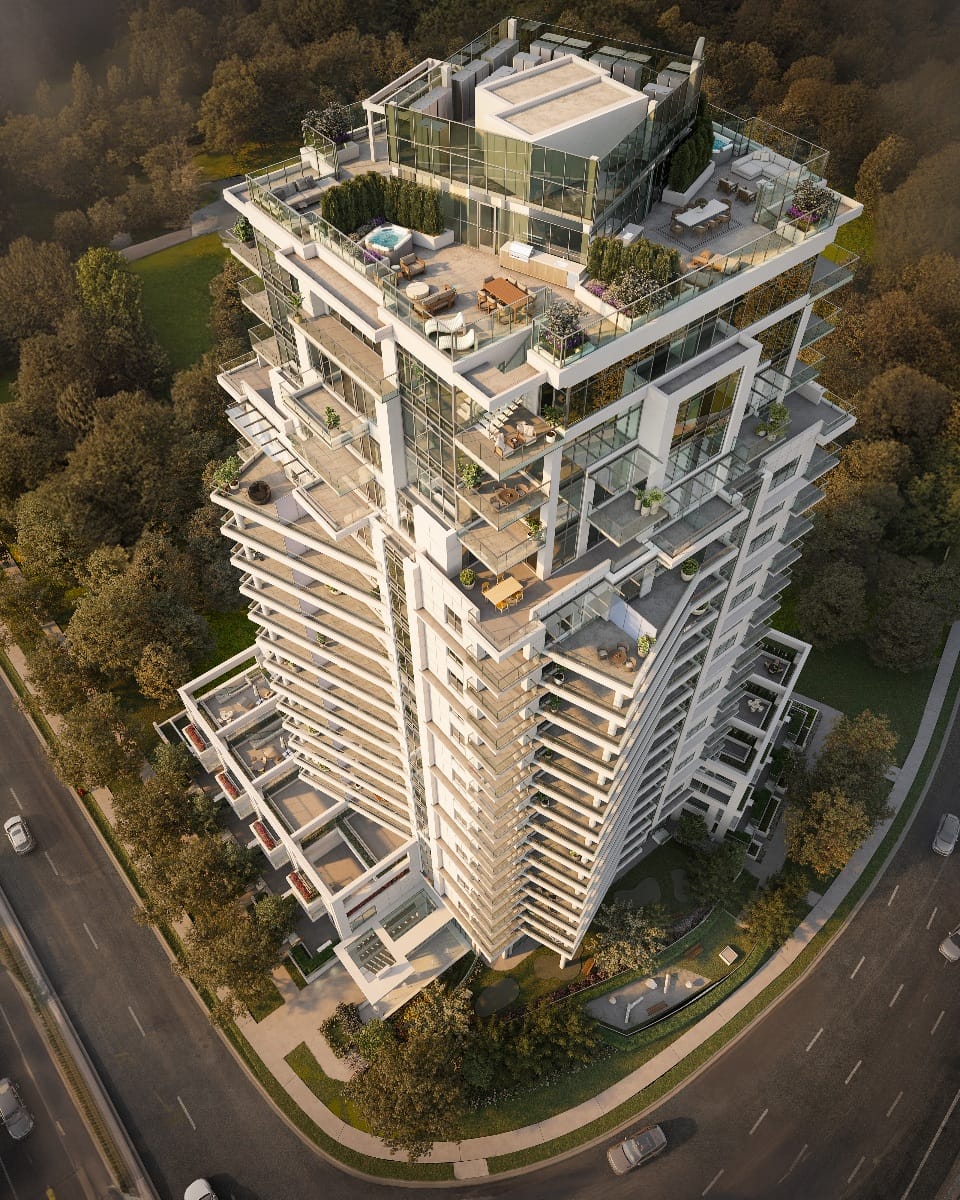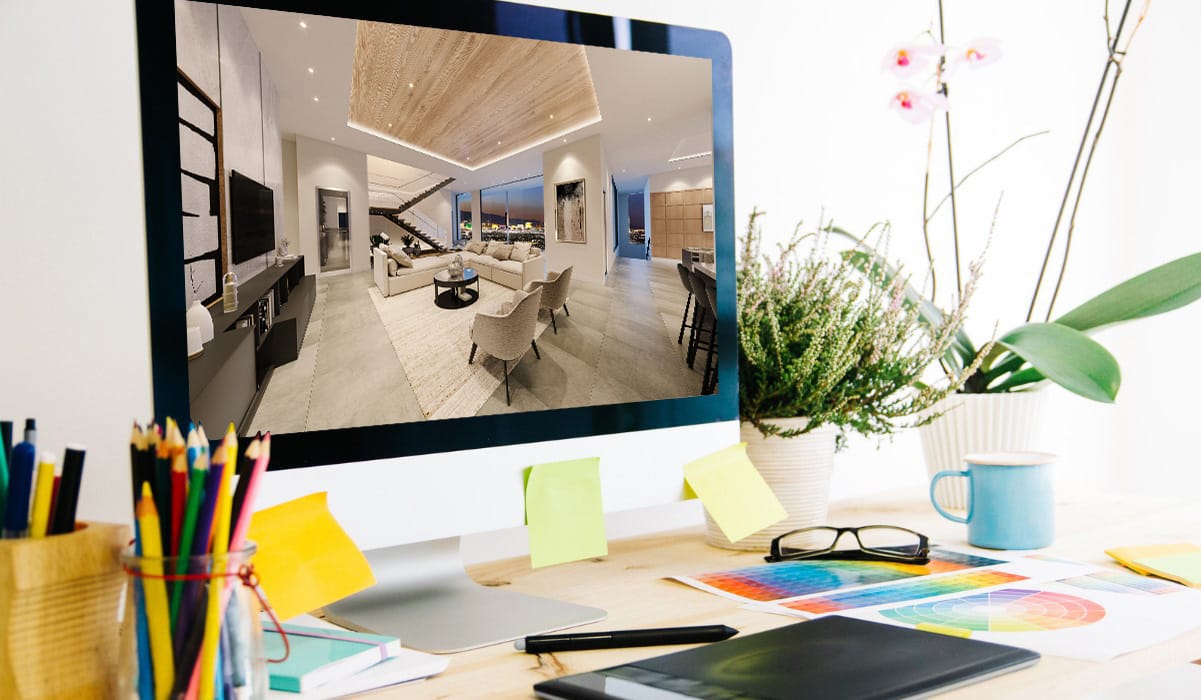Architectural rendering is the process of creating lifelike digital images or animations that show what a building will look like before it’s built. In 2025, it’s more essential—and more accessible—than ever. Whether you’re an architect, property developer, designer, or marketer, 3D architectural rendering has become a standard tool for bringing ideas to life long before construction begins.
Today’s rendering workflows are faster, smarter, and more collaborative. With the rise of AI-enhanced rendering tools, real-time visualization, and cloud-based collaboration, teams can now work together seamlessly from anywhere in the world. This shift has opened the door for rendering online, where clients and studios connect virtually to deliver high-quality visuals with fewer delays and more flexibility.
In this updated guide, we’ll walk you through everything you need to know about architectural renderings in 2025—from the basics and types of renderings, to how they’re created, who uses them, and what they cost. You’ll also find expert tips, real-world examples, and links to helpful tools like our live cost calculator and case study portfolio.
Whether you’re new to 3D rendering or ready to sharpen your strategy, this guide will help you make confident, informed decisions.
New to outdoor visuals specifically? Read our focused guide: What Is 3D Exterior Rendering for a clear overview of process, tools, and outcomes.
Key Takeaways
- What is Architectural Rendering? It refers to CGI-generated images used to visually represent a building’s design concept before it’s built. These renderings help clients, architects, and developers visualize projects clearly and realistically.
- Versatility Across Industries: While rooted in architecture and real estate, 3D renderings are also used in marketing, product design, advertising, and entertainment (like games and film).
- Business Applications: Renderings play a key role in presales, stakeholder presentations, design approvals, and portfolio marketing.
- Types of Renderings: Common formats include residential, commercial, landscape, and high-rise or skyscraper renderings, each suited to different project goals.
- Workflow Summary: 3D renderings follow a clear process—modeling, lighting, texturing, and post-production—to turn design files into realistic visuals.
- Key Benefits: Better communication, faster approvals, and stronger marketing performance across architecture and real estate projects.
What Are Architectural Renderings?

Architectural renderings are computer-generated images (CGI) that represent the visual design of a proposed architectural space or structure. These images help communicate a building’s design, layout, materials, and atmosphere long before physical construction begins.
Renderings are commonly used to:
- Visualize unbuilt or renovated properties
- Present concepts to clients or planning authorities
- Market developments during pre-sales
- Showcase work in professional portfolios
Renderings typically start from architectural plans or CAD drawings, which are transformed into detailed 3D models. These models are then enhanced with realistic lighting, textures, landscaping, and context elements to produce a final visual that is as close to the real thing as possible.
To create these visuals, professionals rely on powerful architectural rendering software that enables precision, realism, and efficiency at every stage.
Learn the differences between 3D rendering and 3D modeling to understand how design data becomes visual imagery.
In a competitive real estate and design landscape, high-quality architectural renderings are now a must-have tool to inform, inspire, and sell ideas.
For more tips on image quality, see How to Create High-Quality Photorealistic Renderings.
What Is CGI and How Is It Used?

CGI, or Computer-Generated Imagery, is the broader field that powers architectural renderings. It refers to the creation of still images or animations using computer software, and it’s used across multiple industries beyond architecture.
Here are some of the most common uses of CGI:
In Film and Entertainment
CGI is used to create everything from fully animated films to subtle visual effects in live-action movies. It enables the creation of environments, characters, and effects that would be impossible or too expensive to capture on camera. One of the most iconic studios using CGI extensively is Pixar, known for its groundbreaking animated films.
In Video Games
In gaming, CGI is used to render 3D environments and characters in real-time as the player interacts with the world. This same technology also supports architectural visualization by allowing interactive walkthroughs or virtual staging.
In Product Marketing
Brands often use CGI to visualize new products before they physically exist. From smartphones to vehicles to food, CGI allows marketers to present polished, consistent visuals that support campaigns across digital and print media. Even global brands like McDonald’s use CGI to create highly stylized ads that showcase products in ways that aren’t always possible with traditional photography.
While these uses differ in purpose, they share a common foundation: the ability to present ideas visually before they exist in the real world. In architecture, this power translates directly into faster decisions, better communication, and more impactful marketing.
Usage of CGI in Architecture & Real Estate

In the architectural world, CGI isn’t just about flashy visuals—it’s a strategic tool that improves decision-making, enhances marketing, and drives project momentum. Here’s how it’s commonly used:
Pre-Sales & Marketing
3D architectural renderings are essential for selling real estate before construction begins. Developers use photorealistic renderings in brochures, websites, and listings to help buyers understand what they’re investing in, often leading to faster sales and higher pre-sale conversion rates.
Investor Presentations
A compelling rendering can bring an idea to life for stakeholders who need to see more than a blueprint. CGI helps secure funding and support by visually articulating a project’s potential.
Client Communication
Instead of relying on technical drawings or written descriptions, renderings help clients visualize the finished project—which improves collaboration, reduces miscommunication, and increases approval rates.
Design Development
Architects and engineers use renderings to spot design flaws, test material options, and experiment with spatial arrangements before construction begins. This results in better planning and fewer costly revisions down the line.
Competitions & Planning Approvals
Well-crafted CGI renderings are often the key differentiator in architecture competitions and public project submissions. They not only communicate the concept, but also demonstrate professionalism and attention to detail.
Portfolio & Brand Building
Whether you’re an architect, designer, or developer, keeping your portfolio fresh with unbuilt but beautifully rendered projects is a great way to attract new clients and showcase creative thinking.
Our Luxury Home Design Renderings in Nevada showcase how architectural rendering transforms early concepts into investor-ready visuals.
Who Are Architectural Renderings Useful For?

The demand for high-quality 3D Architectural Renderings is particularly strong in the real estate and design industries, where visuals are critical to driving interest and closing deals. These renderings support every stage of the sales and design process, providing clarity, engagement, and strategic advantage.
Here are the professionals who benefit most from architectural renderings:
Real Estate Developers
Developers rely on 3D renderings to market and pre-sell properties before they’re built. Visuals help showcase different material options, layouts, and lighting scenarios, allowing buyers to make confident decisions early on. Learn more about how real estate developers use 3D rendering.
Architects
For architects, 3D rendering is an essential part of the design communication process. It allows them to present design concepts with clarity, iterate quickly, and collaborate better with clients, engineers, and planning authorities. Many rely on advanced 3D rendering software to fine-tune every detail.
Interior Designers
Interior designers use renderings to experiment with colors, furnishings, lighting, and spatial arrangements. This gives clients a realistic preview of the space and makes approvals faster and more informed.
Real Estate Agents
Agents use 3D visuals to enhance property listings, websites, and marketing materials. Renderings can show furnished interiors, alternative layouts, or potential upgrades, helping properties stand out in a competitive market.
Common Types of Architectural Rendering
Architectural renderings come in many forms, each tailored to different project goals, audiences, and levels of detail. Choosing the right type of rendering can help convey your vision more clearly, whether you’re pitching an idea, marketing a development, or refining a design.
Residential Renderings
These are among the most common and are used to depict single-family homes, townhouses, and apartment interiors or exteriors. Residential renderings are great for showcasing layout options, material choices, and lighting variations to buyers or homeowners.
Commercial Renderings
These renderings represent office buildings, retail complexes, restaurants, and mixed-use developments. Commercial projects often require a higher level of detail to capture signage, pedestrian traffic, and surrounding infrastructure. They’re often used in leasing packages and marketing brochures.
High-Rise and Skyscraper Renderings
Taller, urban-scale projects like towers and skyscrapers require dramatic perspectives and advanced detailing. These renderings are used to communicate scale, urban integration, and skyline aesthetics to city planners, investors, and the public.
Landscape Renderings
Focusing on the outdoor environment, landscape renderings show how parks, gardens, courtyards, and green roofs will look once completed. These visuals help stakeholders understand spatial flow and environmental features in large developments.
Townhouse and Multi-Unit Residential Renderings
Multi-family housing developments often sit between residential and commercial renderings in scale. These renderings highlight façade continuity, shared outdoor spaces, and walkability to support zoning applications or community engagement.
Each type of rendering requires a different level of planning and visual strategy, and working with an experienced team ensures that the end result fits both the functional needs and emotional goals of your audience.
Cost of Architectural Renderings

The cost of 3D architectural rendering can vary significantly based on project size, scope, and level of detail. Whether you’re visualizing a single-family home or a large mixed-use development, prices typically start around $800 per image and can scale into the thousands for larger or more complex projects.
To make pricing more transparent, we’ve built a live cost calculator so you can estimate the cost of your project in seconds.
3D Rendering Price Estimates (2025)
| Project Size | Examples | Estimated Price (per image) | Turnaround Time |
|---|---|---|---|
| Small | Single-family homes, apartments | $800–$1,400 | 1–2 weeks |
| Medium | Townhouses, condominiums | $1,000–$1,800 | 2–3 weeks |
| Large | Malls, mixed-use, skyscrapers | $1,200–$3,000+ | 3–5 weeks |
Need an exact figure? Use our Rendering Cost Calculator to get a custom quote based on your image count and project scale.
3D Rendering Process Workflow

Creating a high-quality 3D architectural rendering is a multi-step process that transforms design files into photorealistic visuals. Here’s a breakdown of the typical workflow used by professional studios:
Step 1: 3D Modeling

The process begins by converting architectural plans (like CAD files or sketches) into a 3D model. This model forms the foundation of the rendering and defines the shape, proportions, and structure of the space. Learn more about the difference between 3D rendering and 3D modeling.
Step 2: Art Direction

Once the model is ready, the team works with the client to establish the visual mood. This includes decisions around materials, lighting, furniture, environment, time of day, and any human or lifestyle elements. Mood boards and reference images are often shared at this stage.
Step 3: Grayscale Previews

Before adding color or textures, grayscale renderings are produced to explore different camera angles and ensure accurate geometry. This is the client’s first look at the project, and it’s the best time to make structural corrections.
Step 4: Color & Texture Rendering

The model is enhanced with lighting, materials, and realistic textures based on the approved art direction. This results in the first photorealistic draft, ready for detailed client feedback.
Step 5: Revisions & Final Rendering
After reviewing the draft, the client can request changes (most studios include 1–2 rounds of revisions). Once approved, the final rendering is produced in high resolution, ready for use in marketing, presentations, or project planning. For guidance on image output, see our Ultimate Render Resolution Guide.
Timeline of a 3D Rendering Project

The duration of a 3D architectural rendering project can vary significantly depending on the scale, complexity, and number of deliverables. While small projects can be completed in under a week, large-scale developments may take several weeks or longer.
Below is a general overview of estimated turnaround times based on project type:
Estimated Timelines by Project Size
| Project Type | Typical Turnaround Time |
|---|---|
| Single-Family Home | 7–10 days |
| Townhouses / Multi-Family | 2–3 weeks |
| High-Rise / Skyscraper | 3–4 weeks |
| Large Urban Masterplans | 6+ weeks (phased delivery) |
What Affects Project Duration?
Several factors influence how long a rendering takes to complete:
- Project size and detail level
- Number of views or images required
- Availability of references (CAD files, material specs, etc.)
- Rounds of revisions requested
- Whether the timeline is expedited
Many studios, including NoTriangle, offer express delivery options when faster turnaround is required.
Timelines also depend on how well-organized your materials are from the beginning. Providing clear references and feedback helps keep the project moving efficiently.
Choosing a CGI Studio and Starting the Job

Selecting the right rendering studio can make or break your project. The right team should not only have strong visual skills, but also be great communicators, detail-oriented collaborators, and aligned with your project’s vision.
1. Review Their Portfolio
Always start by looking at a studio’s portfolio. This gives you a sense of their style, quality, and range. Make sure they’ve worked on similar project types and understand your market.
2. Ask About Their Process
Understanding how a studio works will help set expectations around communication, timelines, and revisions. A good team will walk you through their workflow, explain their tools, and recommend the best rendering approach for your goals.
3. Evaluate Communication
Pay attention to how they respond in the early stages. Are they asking the right questions? Are they proactive? Clear and timely communication is a sign of a professional studio that will be easy to work with under pressure.
4. Start with a Small Scope
If you’re unsure, consider starting with one or two images before committing to a full project. This allows you to assess their quality, responsiveness, and ability to capture your vision before scaling up.
By partnering with a skilled and reliable CGI studio, you’ll not only receive stunning renderings—you’ll also gain a trusted extension of your design team, ready to help you bring your ideas to life with clarity and impact.
Learn More About Architectural Visualization
Deepen your understanding of 3D visualization with these related guides:
- 3D Rendering Basics — foundational concepts and tools.
- 3D Rendering vs 3D Modeling — how geometry becomes imagery.
- How to Create High-Quality Photorealistic Renderings — expert lighting and texture tips.
- Top Benefits of 3D Exterior Rendering – how realistic visuals improve communication, streamline approvals, and strengthen marketing outcomes
- Coming soon: Step-by-Step Workflow of 3D Exterior Rendering
Conclusion
Architectural renderings play a pivotal role in bringing design concepts to life—both in architecture and beyond. They provide a visual bridge between vision and reality, helping designers, developers, and marketers communicate ideas with accuracy and emotion.
Thanks to advances in CGI, renderings are now more detailed, immersive, and accessible than ever. From real estate presales and investor decks to client presentations and marketing portfolios, 3D architectural renderings offer unmatched value at nearly every stage of a project.
These visuals aren’t just decorative—they are persuasive, strategic assets. With the rise of AI, rendering technology continues to evolve into tools that can enhance workflows, simulate lighting or textures, and support faster, smarter design decisions. Explore the possibilities in our blog: AI for Architects.
While rendering costs vary depending on project type and scope, the investment often leads to fewer design mistakes, faster approvals, and improved sales outcomes. By understanding the full process and working with the right studio, you can unlock the full potential of your design.
Curious how long your project might take? Read our guide: How Long Does It Take to Render a House?.
FAQs
Architectural renderings are computer-generated visuals that show how a building or space will look before construction.
CGI helps developers pre-sell properties, attract investors, and present accurate visuals that speed up approvals.
It involves 3D modeling, lighting, texturing, and post-production to create realistic images or animations.
Common types include commercial, residential, skyscraper, and landscape renderings, each tailored to the specific needs of the project.
The cost of architectural renderings varies based on the project’s complexity and requirements, ranging from $300 per image to several thousand dollars for larger projects.
Bring Your Vision to Life with Expert 3D Exterior Rendering
Turn your architectural concepts into photo-realistic visuals that captivate investors and clients. Our 3D Exterior Rendering Services deliver precision, realism, and speed — from concept to presentation.







